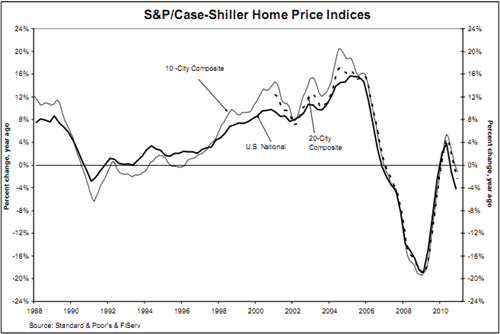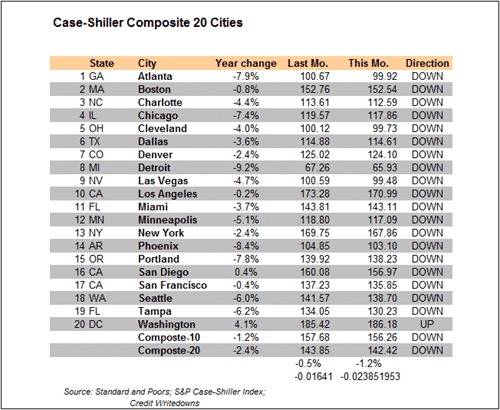Case-Shiller: US House Prices Are Closing In On the Post-Bubble Trough
The S&P/Case Shiller Home Price Indices shows that house prices in the U.S. continue to decline this winter. For data through December 2010, the broad Composite-20 index is down 2.4% compared to December 2009. The Composite-10 index is down 1.2% in that time frame. While these numbers were in line with expectations, they point to a continuing double dip in housing.
For example, last year house prices weakened month-on-month in many markets as the pickup from the summer selling season waned. Yet, even as the breadth of housing markets with month-on-month gains declined, year-on-year numbers improved through May. Further, at this point last year, there were still four markets in the Composite-20 which showed month-on-month gains; this year there is only one, Washington D.C., where prices have been buoyed by the expansion in federal government spending. Crucially, the year-on-year numbers actually started to turn down just as the summer selling season ramped up in May 2010 because of the expiration of the home buyers’ tax credit.
Last month, I looked back at the Case/Shiller posts I did a year ago and found that the trend is definitely weaker this year. This month, I thought it would be interesting to look at the index levels as a sign of strength in individual markets. The Case-Shiller Index values start uniformly at 100.0 in January 2000. So, the index levels are apples-to-apples comparisons.
The markets which doubled in price during the bubble are:
- Miami: 280.87
- Los Angeles: 273.94
- Washington D.C.: 251.07
- San Diego: 250.34
- Tampa: 238.09
- Las Vegas: 234.78
- Phoenix: 227.24
- San Francisco: 218.37
- New York: 215.83
All of these markets have seen the most extreme levels of house price deflation except Washington D.C. and New York. The markets today where prices are still 50% higher than in January 2000 are:
- Washington D.C.: 186.18
- Los Angeles: 173.28
- New York: 169.75
- San Diego: 160.08
What does all this suggest about the housing bubble? To my mind, it speaks first and foremost to the power of fiscal stimulus. The reason Washington D.C. has done relatively well of all the bubble markets is because federal spending has cushioned the market. In New York, the bailouts of the financial sector where we have seen over $130 billion in bonus compensation is clearly keeping that market high. San Diego and LA have seen greater percentage declines and are still over the 50% mark merely because they were so high before the bubble burst.
Markets tend to overshoot to the downside as well as to the upside. If U.S. housing markets do overshoot, we could see another 15-20% down from here.


Comments are closed.